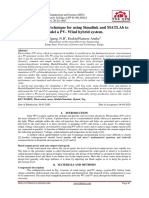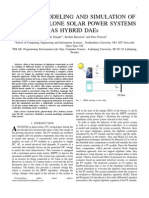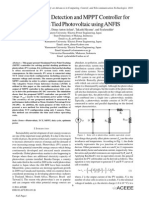Publication 1
Publication 1
Uploaded by
Mahamudul HasanCopyright:
Available Formats
Publication 1
Publication 1
Uploaded by
Mahamudul HasanCopyright
Available Formats
Share this document
Did you find this document useful?
Is this content inappropriate?
Copyright:
Available Formats
Publication 1
Publication 1
Uploaded by
Mahamudul HasanCopyright:
Available Formats
2012 7th International Conference on Electrical and Computer Engineering 20-22 December, 2012, Dhaka, Bangladesh
607
A Modified Simulation Method of Photovoltaic Module in Simulink Environment
Hasan Mahamudul, 1,* Mekhilef Saad, 2 and Metselaar, Ibrahim Henk
Department of Mechanical Engineering, University of Malaya. 2 Department of Electrical Engineering, University of Malaya 3 Center for Advanced Materials Research, University of Malaya Kuala Lumpur , Malaysia * hasan_041097@yahoo.com
AbstractThis paper represents a versatile simulation process of a photovoltaic module mainly using matlab function in simulink platform. To analyze the characteristics curves single diode circuit model and a SOLKAR 36 W PV module is used. The P-V and I-V curves obtained from this model for various radiations and temperature are investigated. This model can also be used for the simulation of any specified PV module with least changing in parameters. Index TermsSimulation, PV module, Simulink.
1
I. INTRODUCTION To overcome the challenge of energy for the world needs from the last few decades a lot of research is going on renewable energy among them solar energy is the pioneer, at present a lot of research is going on this area. The sun is a constant unique source of energy as long as the world exists, the sun will continue to give its energy to the earth. Unfortunately, a very small amount of the huge energy which sun gives to earth can be utilized. Data shows that the amount of power which comes from the sun to the earth is nearly 1.81011 MW [13] and its really difficult to believe that the worlds rate of energy consumption is only 0.1% of this gigantic amount. On the other hand, due to the depletion of energy source like coal, oil and natural gas with the rapid growth of population and dramatic industrialization a long term solution of energy crisis must be found. Thats why most of the research at this moment is going on how more energy can be captured from the sun.[2][3] Photovoltaic system is the most fundamental technique to utilize solar energy and this system is formed by photovoltaic cell which is actually a photoactive semiconductor material, it absorbs the light energy and converts it into electricity. The most important factors which make it more popular is, this conversion of energy is free from any kind of pollution and carbon-di-oxide (CO2) emission .Also, it does not need that much maintenance and operation cost is low.[3][4] The efficiency of a PV system depends on the parameters like temperature, solar radiation, variation in sunlight, shadow e.t.c. Basically, the generation of energy from the PV system varies with its environmental and operational conditions. The first step of any research with PV system is the modelling of PV module to determine the characteristic curves of the system, because the selection of others necessary topologies such as Maximum power point tracking algorithm (MPPT) and converter selection are mostly depend on these curves. The simulation and modelling process of Photovoltaic module is upgraded day by day for the better understanding of its work by the researcher. For the performance analysis of a PV
978-1-4673-1436-7/12/$31.00 2012 IEEE
system presently PV balance of system(BOS) research uses mathematical function based modeling. But this model could not be utilized immediately by the professionals due to a high failure rate. As a result the modification and simplification of PV module is continuing to make its performance better. [7] In this paper a very simple procedure of PV module simulation is illustrated with user friendly matlab function blocks from the simulink libraries. In part II. The necessary equivalent circuit model is demonstrated and described. All the mathematical equations related to PV system are also included in this portion. In part.III simulink implementation of the whole system is shown. In III.A. Complete block diagram of PV panel and III.B internal equation based function diagram is illustrated. Familiarization with some special signal blocks is also enclosed here. In part IV. The characteristic curves obtained using this model is attached here sequentially to investigate. At last, In part V. A precise conclusion is added to finalize the work. II. MODELLING OF PV CELL AND MATHEMATICAL EQUATIONS A PV cell can be modelled using the following equivalent circuit [2], [8], as shown in figure 1.
Figure.1 Electrical equivalent circuit of PV Cell
Here, Ro is the load resistance, Rs is the series resistance and Rsh represents the shunt resistance. Due to the much higher value of Rsh with respect to Rs, the shunt resistance is neglected for the simplification of the modelling [5]. The output current of a PV cell can be calculated using [14] I0=Iscr/ (e qVoc/kT-1) Where: Iscr is the short circuit photon generated current. k is Boltzmanns constant. T is the cell operating temperature in Kelvin (K). q is the charge of an electron. V oc is open circuit voltage. (1)
608
A series of PV cells which are connected together is called a string and a module is made of cell strings. The equivalent circuit of a PV module can be illustrated in figure 2. [8]
And the from[9]:
cell reverse saturation current Irs is calculated (4)
Irs =Irr [T/Tr] exp (qEg/kA [1/Tr-1/T])
Where: Irr is the reverse saturation current at Tr. Eg is the band gap energy of the semiconductor used in the cell. The above four are the main equations for the mathematical modelling of a photovoltaic module .The main input parameters used for this simulation are T, S, ns, np And Vin which is considered as triangular wave with a maximum value of Voc. (2) By changing only these parameters any specific PV module can be simulated. SOLKAR 36 W PV module is used here [6] as an example and Electrical Characteristics data of the module is given in table 2.
Table.2 SOLKAR 36 W PV module specification
Figure.2 Electrical equivalent circuit of PV module
The output current of a PV module is defined as [9], [10] Io = npIph npIrs [exp (k0 V/ns)-1]
Where I0 is the PV array output current, V is the array output voltage, Iph is the cell photocurrent that is proportional to solar irradiation. Irs is the cell reverse saturation current that mainly depends on temperature. ns and np are the number of series and parallel cells in the PV module respectively. Ko is a constant [9], calculated from: K0=q/kTA Where: A is the p-n junction ideality factor. Its value depends on PV technology [12]
Table 1. Factor A for different PV technology
Maximum power Voltage at(Vmpp) Current at(Impp) Open circuit Voltage(Voc) Short Circuit current(Isc) Short circuit current temperature coefficient(Ki) Open circuit voltage coefficient(Kv) Number of series cell(Ns) Number of parallel cell
37.08 W 16.56 V 2.25 A 21.24 V 2.55 A (0.065+0.015)%/C -(160+20)mv/C 36 1
III. SIMULINK IMPLEMENTATION OF THE PV MODULE The modelling is based on mathematical equations and the above equations (2), (3), (4) are used here consequently to obtain the PV output current, voltage and power for required conditions For this some special simulink block is used such as;
Table .3 Important simulink block
Technology Si Mono Si-poly a-Si:H a-Si:H tandem a-Si:H triple CdTe CTS AsGa
A 1.2 13 18 3.3 5 1.5 1.5 1.3
For PV input voltage
In equation (2), cell photocurrent Iph is calculated from[9]: Iph= [Iscr +Ki (T-Tr)] S/100. Where: S T Tr Ki is Solar irradiation. is cell operating temperature. is the reference temperature. is short circuit current coefficient. (3)
For variable temperature and irradiation input
For including the mathematical equations in the model for Iph, Irs and Ipv
609
A.
Complete simulink block diagram of PV system
Fig.3: Simulink block diagram of PV System.
B .Internal equation based function diagram of the PV Panel
Fig.4: Internal equation based function diagram of PV panel
610
IV. CHARACTERISTICS CURVES ANALYSIS A. P-V and I-V curves for various temperatures
V. CONCLUSIONS This model is a modified and simple way of photovoltaic module simulation. The characteristic curves obtain from this model are matched with the theoretical result which ensures the validation of this model. Further extension and future work like MPPT algorithm implementation, partial shading effect analysis, converter connection for supplying load in standalone PV system, smart grid photovoltaic interconnection e.t.c can make use of this model as a fundamental stage. ACKNOWLEDGMENT The authors wish to thank all the members of Renewable energy cluster of University of Malaya for their kind cooperation.This work is under an ongoing project of University of Malaya (UM.C/HIR/MOHE/ENG/21-Phase Change Materials for Energy Storage System).Authors would like to thank the University Research grant authority for their necessary economic support. REFERENCES
[1] S. Nema, R.K.Nema, and G.Agnihotri, Matlab / simulink based study of photovoltaic cells / modules / array and their experimental [2] Jee-Hoon Jung, and S. Ahmed, Model Construction of Single Crystalline Photovoltaic Panels for Real-time Simulation, IEEE Energy Conversion Congress & Expo, September 12-16, 2010, Atlanta, USA. [3] I. H. Altas and A.M. Sharaf, A Photovoltaic Array Simulation Model for Matlab-Simulink GUI Environment, IEEE, Clean Electrical Power, International Conference on Clean Electrical Power (ICCEP '07), June 14-16, 2007, Ischia, Italy. [4]S.Chowdhury, S.P.Chowdhury, G.A.Taylor, and Y.H.Song, Mathematical Modeling and Performance Evaluation of a Stand-Alone Polycrystalline PV Plant with MPPT Facility, IEEE Power and Energy Society General Meeting - Conversion and Delivery of Electrical Energy in the 21st Century, July 20-24, 2008, Pittsburg, USA. [5]M.Veerachary,Power Tracking for Nonlinear PV Sources with CoupledInductor SEPIC Converter, IEEE Transactions on Aerospace and Electronic Systems, vol. 41, No. 3, July 2005. [6] N. Pandiarajan and R. Muthu, Mathematical Modeling of Photovoltaic Module with Simulink, in Proceedings of the International Conference on Electrical Energy Systems (ICEES
Figure.5: I-V curve for 25C, 45C and 65C.
Figure.6: P-V curve for 25C, 45C and 65C.
B. P-V and I-V curves for various irradiations
11), Jan 2011.
[7] N Pandiarajan and R Muthu, Development of Power ElectronicCircuit Oriented Model of Photovoltaic Module, International Journal of Advanced Engineering Technology, vol. 2, no. 4th, pp. 118127, 2011.), Jan 2011. [8] K Kachhiya, M Lokhande and M patel , Matlab/Simulink Model of Solar Module and MPPT algorithm , in Proceedings of the National Conference on Recent trends in Engineering & technology [9] Safari. A and S. Mekhilef Simulation and Hardware Implementation of Incremental Conductance MPPT with Direct Control Method Using Cuk Converter IEEE Transactions on Industrial Electronics, Vol. 58, Issue 4, 2011, 1154 -1161 [10] G. Petrone, G. Spagnuolo, R. Teodorescu, M. Veerachary, and M. Vitelli,Reliability issues in photovoltaic power processing systems, IEEE Trans. Ind. Electron., vol. 55, no. 7, pp. 2569--2580, Jul. 2008. [11] C. Hua, J. Lin, and C. Shen, Implementation of a DSP-controlled photovoltaicsystem with peak power tracking, IEEE Trans. Ind. Electron.,vol. 45, no. 1, pp. 99--107, Feb. 1998. [12] Rakesh A.Patel Design and Implementation of single phase grid connected Photovoltaic Inverter using DSP,Nirma University of Science and Technology Ahmedabad, May 2008. [13]R. Messenger and J. Venture Photovoltaic System Engineering, CRC Press,2000,pp.41-51 [14] Akihiro Oi Design and Simulation of photovoltaic water pumping system Thesis faculty of California polytechnic State University San Luis, Sep ,2005.
Figure.7: P-V curve for 1000W/m2, 500 W/m2 and 100 W/m2 irradiation
Figure.8: I-V curve for 1000 W/m2, 500 W/m2 and 100 W/m2 irradiation.
You might also like
- Canon Finisher Booklet v2 SMDocument214 pagesCanon Finisher Booklet v2 SMxkaravi0% (1)
- Modeling and Control of DC-DC Boost Converter Using K-Factor Control For MPPT of Solar PV SystemDocument6 pagesModeling and Control of DC-DC Boost Converter Using K-Factor Control For MPPT of Solar PV SystemHoang ManhNo ratings yet
- Ge Sitepro 20kvaDocument5 pagesGe Sitepro 20kvaNilson Eduardo Torres100% (1)
- A Step by Step Technique For Using SimulDocument10 pagesA Step by Step Technique For Using SimulhajasoftwareNo ratings yet
- A Comparative Study of PV Models in Matlab/SimulinkDocument6 pagesA Comparative Study of PV Models in Matlab/SimulinkJaime Zapata AmoresNo ratings yet
- (ART) A Photovoltaic System Model For Matlab Simulink PDFDocument5 pages(ART) A Photovoltaic System Model For Matlab Simulink PDFMustapha El MetouiNo ratings yet
- Analysis The Performance of PV System To Get Maximum Energy Under Different Environmental ConditionDocument21 pagesAnalysis The Performance of PV System To Get Maximum Energy Under Different Environmental ConditionrajNo ratings yet
- Comparison of PV Panels MPPT Techniques Applied To Solar Water Pumping SystemDocument10 pagesComparison of PV Panels MPPT Techniques Applied To Solar Water Pumping SystemInternational Journal of Power Electronics and Drive SystemsNo ratings yet
- 117 1014 1 PBDocument9 pages117 1014 1 PBChithrailingam PerumalNo ratings yet
- Modeling and Simulation of A Solar Photovoltaic SyDocument8 pagesModeling and Simulation of A Solar Photovoltaic SyBRICE ARMANDNo ratings yet
- Modeling and Simulation of Photovoltaic Module Using MATLAB SimulinkDocument6 pagesModeling and Simulation of Photovoltaic Module Using MATLAB SimulinkpraveeneeeNo ratings yet
- Paper PV Model MPP EEE 2012Document12 pagesPaper PV Model MPP EEE 2012Nur MohammadNo ratings yet
- MATLAB/Simulink Model of Solar PV Module and MPPT Algorithm: Kinal Kachhiya Makarand LokhandeDocument5 pagesMATLAB/Simulink Model of Solar PV Module and MPPT Algorithm: Kinal Kachhiya Makarand LokhandeSomil AgarwalNo ratings yet
- Modelling and Simulation of Maximum Power Point TrackingDocument6 pagesModelling and Simulation of Maximum Power Point TrackingNicole GabrielNo ratings yet
- Article 17 Ijaet Volii Issue IV Oct Dec 2011Document10 pagesArticle 17 Ijaet Volii Issue IV Oct Dec 2011Mustapha Maiz Hadj AhmedNo ratings yet
- Accurate MATLAB Simulink PV System Simulator Based On A Two-Diode ModelDocument9 pagesAccurate MATLAB Simulink PV System Simulator Based On A Two-Diode ModelibtihalislamNo ratings yet
- Seminar On DGDocument6 pagesSeminar On DGtejaNo ratings yet
- Modelling SolarDocument9 pagesModelling Solarعامر طايس سعيد عبد الجبارNo ratings yet
- Comprehensive ApproachDocument11 pagesComprehensive ApproachnmotanNo ratings yet
- Modeling of PV Using PSpice and Matlab Fv8xDocument9 pagesModeling of PV Using PSpice and Matlab Fv8xRen Hong GiangNo ratings yet
- A Model For Predicting Photovoltaic Module PerformancesDocument9 pagesA Model For Predicting Photovoltaic Module PerformancesKamil Rasheed SiddiquiNo ratings yet
- Acausal Modeling and Simulation of The Standalone Solar Power Systems As Hybrid DaesDocument7 pagesAcausal Modeling and Simulation of The Standalone Solar Power Systems As Hybrid DaesTaha SellakeNo ratings yet
- 4IJEEEDocument7 pages4IJEEEyipatac291No ratings yet
- Incremental Conductance MPPT Method For PV Systems-LibreDocument3 pagesIncremental Conductance MPPT Method For PV Systems-LibreRushikeshKatkarNo ratings yet
- Mathematical Model Derivation of Solar Cell by Using Onediode Equivalent Circuit Via SimulinkDocument12 pagesMathematical Model Derivation of Solar Cell by Using Onediode Equivalent Circuit Via SimulinkShorav SuriyalNo ratings yet
- 02 Nvee10089Document8 pages02 Nvee10089Edu Daryl MacerenNo ratings yet
- Highly Efficient Analog Maximum Power Point Tracking (AMPPT) in A Photovoltaic SystemDocument11 pagesHighly Efficient Analog Maximum Power Point Tracking (AMPPT) in A Photovoltaic SystemSusmita PandaNo ratings yet
- E3sconf Eece18 04013Document7 pagesE3sconf Eece18 04013dariamonastyrevaNo ratings yet
- International Journal of Engineering Research and DevelopmentDocument8 pagesInternational Journal of Engineering Research and DevelopmentIJERDNo ratings yet
- MATLAB Simulink Based Modeling of Solar PV Cell PDFDocument6 pagesMATLAB Simulink Based Modeling of Solar PV Cell PDFYuvarekha SenthilkumarNo ratings yet
- 2009 - IEEE - Comprehensive Approach To Modeling and Simulation of PV ArraysDocument12 pages2009 - IEEE - Comprehensive Approach To Modeling and Simulation of PV ArraysTalles VianaNo ratings yet
- Publication 3Document23 pagesPublication 3A.K.A KanNo ratings yet
- Simulink Based Model of PV CellDocument7 pagesSimulink Based Model of PV CellFahimNo ratings yet
- Simulation of Photovoltaic Cell Using Matlab: Vijay Garg, Sandeep SainiDocument4 pagesSimulation of Photovoltaic Cell Using Matlab: Vijay Garg, Sandeep SainitheijesNo ratings yet
- Solar Watch SimulationDocument4 pagesSolar Watch SimulationSwapNo ratings yet
- Design of A MPPT For Solar PV System Under Changing Isolation LevelDocument23 pagesDesign of A MPPT For Solar PV System Under Changing Isolation LevelDEBASHISH PARIDANo ratings yet
- Modeling and Simulation of Solar PV Module For ComDocument12 pagesModeling and Simulation of Solar PV Module For ComLayth ZubairiNo ratings yet
- Modeling and Circuit-Based Simulation of Photovoltaic ArraysDocument11 pagesModeling and Circuit-Based Simulation of Photovoltaic ArraysnavidelecNo ratings yet
- Project ReportsDocument45 pagesProject ReportsRahuNo ratings yet
- An Improved Mathematical Model For Computing Power Output of Solar Photovoltaic ModulesDocument10 pagesAn Improved Mathematical Model For Computing Power Output of Solar Photovoltaic ModulesAds SupportNo ratings yet
- 3.1-Study On Temperature For Modeling of PV Array Using TEST DATA PDFDocument4 pages3.1-Study On Temperature For Modeling of PV Array Using TEST DATA PDFRUBIONo ratings yet
- A Photovoltaic System Model For Matlab SDocument5 pagesA Photovoltaic System Model For Matlab SAnh LeNo ratings yet
- Ajassp.2010.682.691 ImpDocument10 pagesAjassp.2010.682.691 ImpulaganathanNo ratings yet
- Fuz MPPT PumpDocument10 pagesFuz MPPT Pumpvintin4uNo ratings yet
- Performance Evaluation of On-Grid and Off-Grid Solar Photovoltaic SystemsDocument5 pagesPerformance Evaluation of On-Grid and Off-Grid Solar Photovoltaic SystemsSojol KumarNo ratings yet
- Modeling and Simulation of PV Systems: April 2018Document12 pagesModeling and Simulation of PV Systems: April 2018ahmad hermawanNo ratings yet
- 154 Icrera2013 SpainDocument10 pages154 Icrera2013 SpainMarian EnachescuNo ratings yet
- Partial Shading Detection and MPPT Controller For Total Cross Tied Photovoltaic Using ANFISDocument5 pagesPartial Shading Detection and MPPT Controller For Total Cross Tied Photovoltaic Using ANFISidesajithNo ratings yet
- Elk 21 2 1 1105 29Document8 pagesElk 21 2 1 1105 29tinhmaixatoi2006No ratings yet
- MATLABSimulink Based Modelling of Solar PhotovoltaDocument7 pagesMATLABSimulink Based Modelling of Solar PhotovoltaDaniel ConstantinNo ratings yet
- Implementation of Standalone Hybrid Power System Using Matlab/simulinkDocument6 pagesImplementation of Standalone Hybrid Power System Using Matlab/simulinkIJIERT-International Journal of Innovations in Engineering Research and TechnologyNo ratings yet
- Labview/Matlab Based Simulator For Grid Connected PV System: Conference PaperDocument7 pagesLabview/Matlab Based Simulator For Grid Connected PV System: Conference PaperEzequiel OlguinNo ratings yet
- Matlab SImulink mô phỏng ma trậnDocument18 pagesMatlab SImulink mô phỏng ma trậnLâmTháiNo ratings yet
- TDH SPDocument67 pagesTDH SPcalin_gecan4018No ratings yet
- (Doi 10.1109/ICMCS.2011.5945712) Amatoul, Fatima Zahra Lamchich, Moulay Tahar Outzourhit, Abdel - (IEEE 2011 International Conference On Multimedia Computing and Systems (ICMCS) - Ouarzazate, MorDocument6 pages(Doi 10.1109/ICMCS.2011.5945712) Amatoul, Fatima Zahra Lamchich, Moulay Tahar Outzourhit, Abdel - (IEEE 2011 International Conference On Multimedia Computing and Systems (ICMCS) - Ouarzazate, MorDiego Quintana ValenzuelaNo ratings yet
- Modeling and Design of MPPT Controller For A PV Module Using PSCAD/EMTDCDocument7 pagesModeling and Design of MPPT Controller For A PV Module Using PSCAD/EMTDCGaurang GuptaNo ratings yet
- Modeling and Simulation of Solar Photovoltaic Module Using Matlab SimulinkDocument4 pagesModeling and Simulation of Solar Photovoltaic Module Using Matlab SimulinkesatjournalsNo ratings yet
- Photovoltaic Modeling HandbookFrom EverandPhotovoltaic Modeling HandbookMonika Freunek MüllerNo ratings yet
- Critical Reading Books VLSI Design PDFDocument7 pagesCritical Reading Books VLSI Design PDFmmorsy1981No ratings yet
- Basic Electronics Presentation v2Document25 pagesBasic Electronics Presentation v2MebreNo ratings yet
- Chapter 16 CMOS AmplifiersDocument94 pagesChapter 16 CMOS AmplifiersZenfox 2k19No ratings yet
- Introduction To MV Design GuideDocument53 pagesIntroduction To MV Design Guideadi_sofa100% (1)
- Diodes and Half-Wave Rectification: 1 AbstractDocument3 pagesDiodes and Half-Wave Rectification: 1 AbstractJannineNo ratings yet
- Melamine Polyimide Composite Fire Resistant Intumescent Coatings (Repaired)Document26 pagesMelamine Polyimide Composite Fire Resistant Intumescent Coatings (Repaired)Satish GuptaNo ratings yet
- Computadora PDFDocument196 pagesComputadora PDFwilson claveria100% (2)
- EKM OmniMeter UL User Manual Spec Sheet SubmeterDocument3 pagesEKM OmniMeter UL User Manual Spec Sheet SubmeterAdam BrouwerNo ratings yet
- KM3x - 256 Based Three-Phase Power Meter Hardware Design Reference ManualDocument17 pagesKM3x - 256 Based Three-Phase Power Meter Hardware Design Reference ManualNovik PrviNo ratings yet
- IC Engine Term PaperDocument7 pagesIC Engine Term PaperAjayendra SinghNo ratings yet
- Induction Motor - Wikipedia, The Free EncyclopediaDocument5 pagesInduction Motor - Wikipedia, The Free EncyclopediakcpatnaikNo ratings yet
- SPWM SVPWMDocument44 pagesSPWM SVPWMAravind MohanaveeramaniNo ratings yet
- Optical CommunicationDocument2 pagesOptical CommunicationVanagara BharatNo ratings yet
- 2nd PPT For VCBDocument15 pages2nd PPT For VCBShaikh Tauqeer AhmedNo ratings yet
- Power Transformer 19-4-16Document40 pagesPower Transformer 19-4-16Pankaj JoshiNo ratings yet
- AN1484 Application Note: A 3.6 Watts Travel Adaptor Using Viper12ADocument11 pagesAN1484 Application Note: A 3.6 Watts Travel Adaptor Using Viper12Avetchboy100% (1)
- AE.1 Lecture 7Document27 pagesAE.1 Lecture 7surafel dagneNo ratings yet
- Chapter4generationofhvacanddcvoltagepart A 170721152911Document64 pagesChapter4generationofhvacanddcvoltagepart A 170721152911Rishabh TalujaNo ratings yet
- Ravim: Degree Coll & University Year CGPA / PercentageDocument2 pagesRavim: Degree Coll & University Year CGPA / PercentagemanojekhiranNo ratings yet
- Programmable Precision Shunt Regulator Tl431/A/C: FeaturesDocument12 pagesProgrammable Precision Shunt Regulator Tl431/A/C: Featureslonewi7427No ratings yet
- Lab Report For CSE 109: East West UniversityDocument6 pagesLab Report For CSE 109: East West UniversityDaudKhanNo ratings yet
- TLP181 Datasheet en 20170512Document9 pagesTLP181 Datasheet en 20170512FranklinNo ratings yet
- Ofc Important QuestionsDocument2 pagesOfc Important QuestionsPriyabrat DashNo ratings yet
- Ele242 Course Material Chapter 3Document21 pagesEle242 Course Material Chapter 3lkjhNo ratings yet
- DS KRT18BM 3 en 50133232Document6 pagesDS KRT18BM 3 en 50133232Saud DareNo ratings yet
- Updated Electronics Module 1 Question BankDocument3 pagesUpdated Electronics Module 1 Question Bankblehbo100% (1)
- 12 Zener Diode-Load RegulatorDocument2 pages12 Zener Diode-Load RegulatorPriyaharshini RaviNo ratings yet
- Tmag 5231Document33 pagesTmag 5231Ali Younis69No ratings yet

























































































